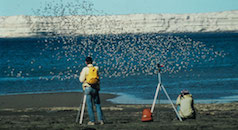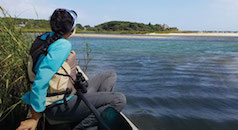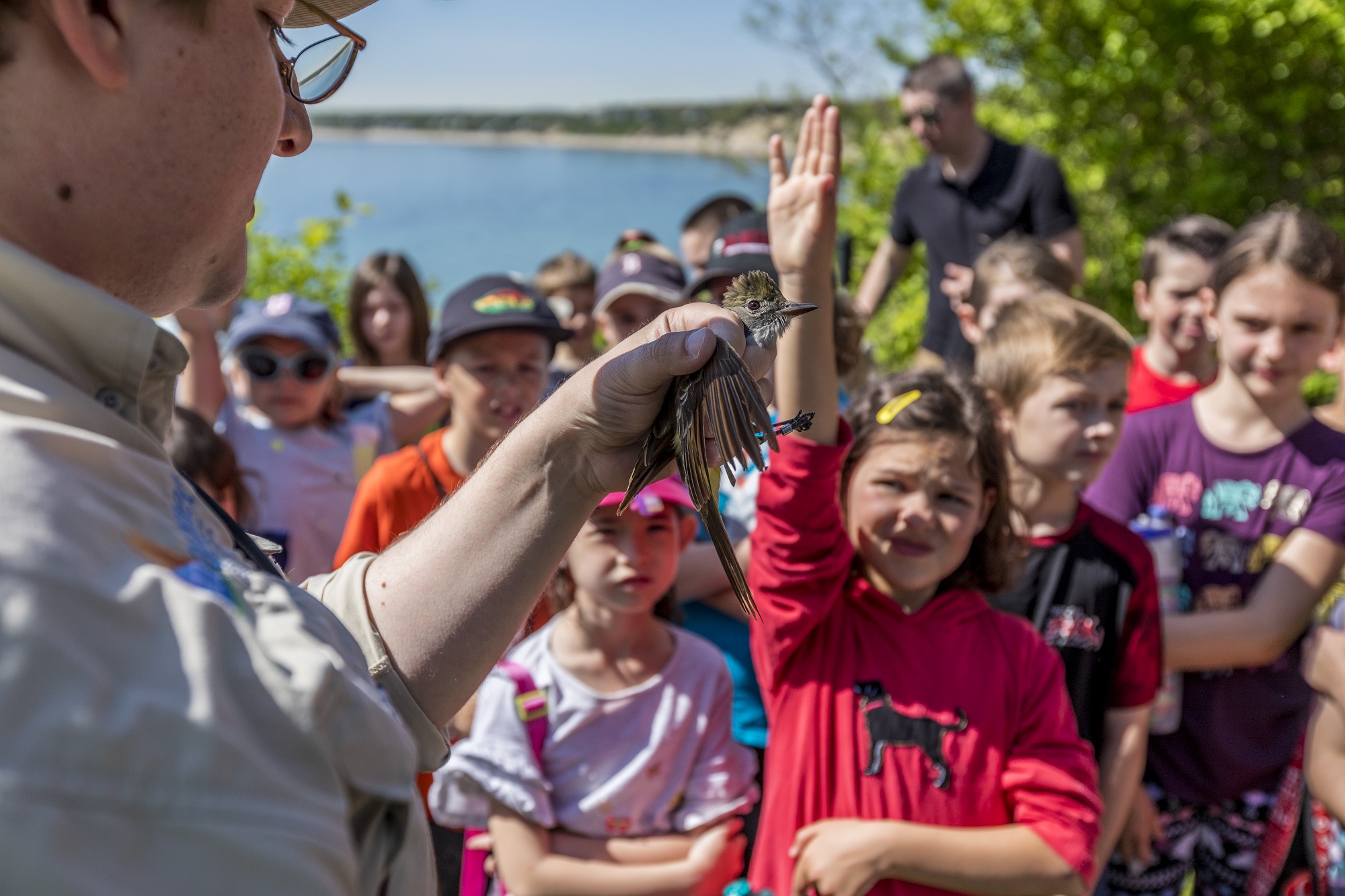Search Results

Plymouth Herring Run Festival
Celebrate Earth Day and the arrival of spring with friends, family, fun, and… FISH! Join us on Saturday, April 22nd from 10 AM—3 PM at the Plimoth Grist Mill for a day of family-friendly activities including herring counts, alewife art, games, live music & more! Chat with local scientists, help contribute to ongoing herring research, and take a photo with Happy Fish! Learn more and find the schedule of activities here. Happy Fish©, created by World Fish Migration Day, is a symbol that connects people, organizations, and projects aiming to restore free-flowing rivers for fish populations. Get excited as Happy Fish makes its way to Plymouth, MA! This festival is free and open to the public with food for purchase....
Happy Hour with Happy Fish
Come see Happy Fish, chat with local scientists, and admire alewife art! Join us on Friday, April 21st from 5—8 PM (with programming from 6-7) at the Plymouth Center for the Arts to kick off our herring migration festivities! Come grab a drink and hors d'oeuvres, take photos with Happy Fish, chat with local scientists, and learn about the importance of the annual herring migration. Happy Fish©, created by World Fish Migration Day, is a symbol that connects people, organizations, and projects aiming to restore free-flowing rivers for fish populations. Get excited as Happy Fish makes its way to Plymouth, MA! This event is free and open to the public with complimentary food and drink. Registration is encouraged. Parking: There...
Results from recent shorebird study provide ‘huge leap forward’ in understanding conservation needs
After nine years of tagging migratory Dunlin, researchers have identified key shorebird habitat along the East Asian-Australasian flyway. By Laura Castañón Every summer along the northern coast of Alaska, the distinctive songs of Dunlin carry across the tundra. The same repeated raspy notes and high-pitched descending trill can be heard in eastern Russia near the Bering Sea and the Sea of Okhotsk, northwest of Canada’s Hudson Bay, along parts of northern Europe and Siberia, and throughout other arctic and subarctic regions. “It’s this repetitive, crazy rattling and screaming breeding display,” says Benjamin Lagassé, a PhD student at University of Alaska Fairbanks who is studying Dunlin. “If you work in a tundra area, even if you’re not into birds, you can’t...
This website will help build collaboration around river herring stewardship in the Gulf of Maine
To protect a local fishery, harvesters, researchers, NGOs, and state and federal agencies come together to share information and engage Maine communities. By Emily Renaud River herring are resilient little fish. Every spring, these aquatic powerhouses migrate from the ocean through rivers and streams to spawn in freshwater ponds and lakes, making them one of just a few anadromous species that use New England’s marine ecosystems. They also play an essential role in coastal food webs; many species rely on river herring as part of their diet, including birds, other fish, mammals, and people. Like many species in the Gulf of Maine, river herring populations have been declining for decades, with climate change, overfishing, and human development as the main...
Build an island for shorebirds? An experiment in Georgia shows the potential
Creating "bird islands" from dredged sediment may help offset climate-driven habitat loss along the Atlantic coast. By Kat J. McAlpine The U.S. Army Corps of Engineers maintains access to all of our country’s waterways, ports, and harbors. Since 1998, the Army Corps has dredged almost 1.3 billion cubic yards of sediment along the Atlantic coast to address coastal erosion and deposition processes and keep navigation open for boats and barges and commerce in general. That amount of sediment is enough to pave 57,000 miles of four-lane highway that could circle the earth’s equator more than two times, says Mike Molnar, director of Manomet’s Coastal Zone Initiative. Most of the dredged materials are typically hauled out to the open ocean and...
New data from satellite transmitters reveals migratory routes of shorebirds in decline
This spring and summer, Manomet scientists and partners tagged over 30 Whimbrels with state-of-the-art GPS trackers in the southeastern U.S. and Arctic. Here’s where those birds are now. By Shiloh Schulte In late May 2022, a team from Manomet and the U.S. Fish and Wildlife Service returned to the Arctic National Wildlife Refuge to continue our collaborative work studying Arctic nesting shorebirds. This year, we worked on several research projects including coastal plain shorebird surveys, a study of shorebird nest survival, remote audio monitoring of nesting birds, and a multi-year tracking study of nesting Whimbrel (Numenius phaeopus). This is difficult work, and only possible thanks to consistent support from Manomet’s individual donors, as well as the National Fish and Wildlife...
Arctic research team faces unprecedented conditions while monitoring shorebirds
Manomet scientists and collaborators are pressing through rough camp conditions to complete key research objectives. By Stephen Brown There is a famous saying based on the Thomas Wolfe novel of the same title: “you can’t go home again.” And if you do try, things will be very different than when you were there before. This year, we went back to the arctic, which feels like “home” to many of Manomet’s field biologists, and true to form things were very different! The arctic is immense, so studying anything at the landscape scale is a huge undertaking. In 2000, we helped develop the Program for Regional and International Shorebird Monitoring (PRISM). In 2002, we launched our first team expedition with U.S. Fish...
Manomet’s Arctic shorebird researchers return to Alaska
This season, the Manomet team and research partners are surveying shorebirds on the Arctic coastal plain and assessing shorebird nesting success. They are also testing new audio recording and machine learning technologies that could greatly expand shorebird monitoring capabilities in remote locations. By Stephen Brown Welcome to the 2022 field season edition of Manomet’s Shorebird Science Blog! We hope you enjoyed our first post about our exciting work underway in Texas with support from the Knobloch Family Foundation. The format of the blog is a bit different from previous years, as you can see; we will be posting a series of articles describing each project as they unfold in the field. This introductory post is just to let you know...
Could quahogs, resilient to Maine’s rapidly-changing waters, soon be as beloved as the oyster?
Story and photos by Emily Renaud Portland, Maine | May 23, 2022 There was a pleasantly briney smell in the air as I walked up the stairs to the second-floor outdoor section at Luke’s Lobster in Portland. From the patio, I overlooked a cluster of docked lobster boats below as Casco Bay, an inlet of the Gulf of Maine, gleamed under the late afternoon sun’s slanting rays. Hungry guests began to trickle in for the evening’s ‘Discover Maine Clams’ event, which was hosted by Manomet and partners Tidal Bay Consulting, Luke’s, Casco Bay Shellfish, and the Casco Bay Regional Working Group. The Gulf of Maine is warming faster than 99 percent of the world’s oceans, forcing it through a unique...
On Cape Cod, genetic sequencing of shorebird prey could revolutionize conservation globally
By Kat J. McAlpine A team of New England scientists, supported by a U.S. Fish and Wildlife Service grant (USFWS), are embarking on new research to discover which prey species–such as worms and shellfish–are sustaining a threatened and fast-declining population of shorebird: the Red Knot found along the western Atlantic, Calidris canutus rufa, sometimes simply called “rufa” for short. What might normally require strenuous efforts to collect buckets of mud, sand, and silt from Red Knot feeding sites on Cape Cod will now only require small test tubes of environmental material. Genetic sequencing technology will do most of the heavy lifting through an analysis of environmental DNA (eDNA), a technique that pinpoints the genetic signatures of organisms within a field...



